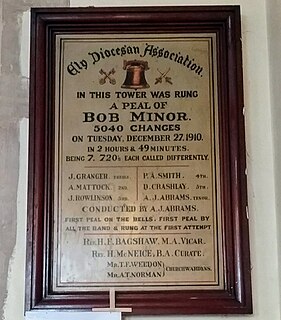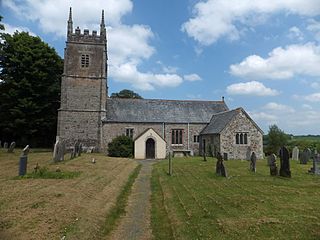
Henry Thomas Ellacombe or Ellicombe (1790-1885), was an English divine and antiquary. He was the inventor of an apparatus to allow a single ringer to ring multiple bells.

Henry Thomas Ellacombe or Ellicombe (1790-1885), was an English divine and antiquary. He was the inventor of an apparatus to allow a single ringer to ring multiple bells.
Ellacombe was born in 1790, the son of the Rev. William Ellicombe, rector of Alphington, Devon. Having graduated B.A. from Oriel College, Oxford in 1812, he applied himself until 1816 to the study of engineering in Chatham Dockyard under the direction of Marc Brunel. In 1816 he proceeded to the degree of M.A. and was ordained for the curacy of Cricklade, Wiltshire in the diocese of Gloucester. The next year, having been ordained as a priest, he moved to Bitton, Gloucestershire, in the same diocese. He held the curacy there until 1835, when he became the vicar of the parish. In 1850 he was presented to the rectory of Clyst St George, Devon, being succeeded in his former benefice by his son, Henry Nicholson Ellacombe (1822–1916), who became a distinguished gardening writer and mentor to the great plantsman E.A. Bowles.
Ellacombe died at Clyst St. George on 30 July 1885, and was buried in the churchyard of Bitton.
Bristol Archives holds 17 volumes of manuscripts, newspaper extracts, transcripts, antiquarian memoranda, drawings and correspondence mainly relating to the ancient parish of Bitton, to the east of Bristol, brought together by Reverend Ellacombe, (Ref. 44786) (online catalogue). Records relating to Henry Thomas Ellacombe can also be found at the British Library Manuscript Collections, [1] Bristol Reference Library, [2] Bodleian Library [3] and Newcastle University Library. [4]
In spite of many difficulties, Ellacombe restored the church of Bitton in 1822, and built three other churches in the wide district under his care, including Christ Church, Hanham, which was constructed under his immediate supervision. [5] In 1843 his parishioners presented him with a testimonial, in which the churchwardens stated that he had been the means of providing church accommodation in the district for 2,285 worshippers, and schoolrooms for 820 children. After his removal to Clyst St. George he rebuilt the nave of the church there, and in 1860 erected a school-house and master's residence.
He was a learned antiquary, and a skilful florist and botanist.
Ellacombe was a great authority on bells, and wrote many books and papers, including Practical Remarks on Belfries and Ringers, The Church Bells of Devon and The Church Bells of Somerset. Together with C. A. W. Troyte and William Banister, he was a leading figure in the formation of the Guild of Devonshire Ringers in 1874.
He invented a device, now known as an Ellacombe apparatus, with chiming hammers, to enable one person to chime all the bells in a tower. In practice, it required considerable and rare expertise for one person to ring changes on several bells, and the apparatus fell out of fashion. Consequently, the Ellacombe apparatus has been removed from many towers in the UK, but there are still often holes in the ceiling which the ropes would come through into the ringing chamber, and often the frames are still in the ringing chamber, without ropes. In towers where the apparatus remains intact, it is generally used like a carillon, to play simple tunes.
His chief writings are:
These works were privately printed.

Exeter Cathedral, properly known as the Cathedral Church of Saint Peter in Exeter, is an Anglican cathedral, and the seat of the Bishop of Exeter, in the city of Exeter, Devon, in South West England. The present building was complete by about 1400, and has several notable features, including an early set of misericords, an astronomical clock and the longest uninterrupted medieval stone vaulted ceiling in the world.

Change ringing is the art of ringing a set of tuned bells in a tightly controlled manner to produce precise variations in their successive striking sequences, known as "changes". This can be by method ringing in which the ringers commit to memory the rules for generating each change, or by call changes, where the ringers are instructed how to generate each change by instructions from a conductor. This creates a form of bell music which cannot be discerned as a conventional melody, but is a series of mathematical sequences.

Robert Hallam was an English churchman, Bishop of Salisbury and English representative at the Council of Constance. He was Chancellor of the University of Oxford from 1403 to 1405.
Campanology is the scientific and musical study of bells. It encompasses the technology of bells – how they are founded, tuned, and rung – as well as the history, methods, and traditions of bellringing as an art.

The Ellacombe apparatus is a mechanism devised for performing change ringing on church bells by striking stationary bells with hammers. It does not produce the same sound as full circle ringing due to the absence of Doppler effect as the bells do not rotate, and the lack of a damping effect from the clapper after each strike.
Ellacombe may refer to:
![Bitton Village in [[South Gloucestershire]], England](https://upload.wikimedia.org/wikipedia/commons/thumb/d/da/The_Grange%2C_Bitton_-_geograph.org.uk_-_1768776.jpg/320px-The_Grange%2C_Bitton_-_geograph.org.uk_-_1768776.jpg)
Bitton is a village and civil parish of South Gloucestershire in England, to the east of the Greater Bristol area on the River Boyd.

Jacobstowe is a village and civil parish on the west bank of the River Okement, about 4 miles (6.4 km) north of Okehampton in the West Devon district of Devon, England.

A "ring of bells" is the name bell ringers give to a set of bells hung for English full circle ringing. The term "peal of bells" is often used, though peal also refers to a change ringing performance of more than about 5,000 changes.

A chime or set of chimes is a carillon-like instrument, i.e. a pitched percussion idiophone consisting of 22 or fewer cast bronze bells. Chimes are primarily played with a keyboard, but can also be played with an Ellacombe apparatus. Chimes are often automated, in the past with mechanical drums connected to clocks and in the present with electronic action. Bellfounders often did not attempt to tune chime bells to the same precision as carillon bells. Chimes are defined as specifically having fewer than 23 bells to distinguish them from the carillon. American chimes usually have one to one and a half diatonic octaves. According to a recent count, there are over 1,300 existing chimes found throughout the world. Almost all of them are located in the Netherlands and the United States, and other countries in Western Europe.

St Mary's Church, Moseley is a Grade II listed parish church in the Church of England located in Moseley, Birmingham. It is now part of a united benefice with St Anne's Church, Moseley. The War Memorial in the South-East corner of the Churchyard, facing Oxford Road, is unusual in that it depicts Christ upon the cross in carved stone. The War Memorial has achieved its own Grade II listing.

A bell-ringer is a person who rings a bell, usually a church bell, by means of a rope or other mechanism.

John Dennys, a poet and fisherman, pioneered Angling poetry in England. His only work The Secrets of Angling was the earliest English poetical treatise on fishing. John Dennys may have been an acquaintance of Shakespeare.
General Sir Charles Grene Ellicombe KCB was an English General and a Royal Engineer, reaching the rank of Colonel Commandant within the Corps. He was created one of the first Companions of the Order of the Bath, and advanced to the honour of a Knight Commander of the Order of the Bath.
The Central Council of Church Bell Ringers (CCCBR) is an organisation founded in 1891 which represents ringers of church bells in the English style.

Rev. Jeremiah Milles (1714–1784) was President of the Society of Antiquaries and Dean of Exeter between 1762 and 1784. He carried out much internal renovation in Exeter Cathedral. As part of his antiquarian research into the history of the parishes of Devon he pioneered the use of the research questionnaire, which resulted in the "Dean Milles' Questionnaire", which survives as a valuable source of historical information.

St Peter's and St Paul's Church is a grade II* listed building and is the parish church of the small market town of Holsworthy, Devon, England. The present church, built in the early English style, dates from the mid-13th century. Renovations in the late 19th century included the complete rebuilding of the chancel, the addition of a north aisle and the renovation of the nave and south aisle. The 15th-century three-stage west tower is 85.75 feet (26.14 m) high and houses a set of eight bells and a carillon. The first building on the site was probably a Norman Oratory built c.1130 and demolished in c.1250. Remnants of the oratory have been incorporated into the south porch.

The Church of St Michael and All Angels is the main Church of England parish church for the suburb of Heavitree, located in the city of Exeter, Devon. The present building is a large and imposing Gothic Revival structure dating back to the 19th century but there has been a church on the site since Saxon times. Designated as a Grade II* listed building by Historic England, the church is notable for its Victorian architecture, tall tower and proximity to the 'Heavitree Yew', an ancient common yew tree within the churchyard amongst the oldest in the county.

The Church of St Mary the Virgin is the main Church of England parish church for the village of Uffculme, Devon, England. First mentioned in a charter dating back to 1136, the present church has a mixture of medieval and Victorian architecture and is a Grade II* listed building. The church building is notable for its rood screen, the longest and oldest in the county, as well as its tall broach spire, a rare feature on churches in Devon.
Campanology is the scientific and musical study of bells. It encompasses the technology of bells – how they are cast, tuned, and rung – as well as the history, methods, and traditions of bellringing as an art. Articles related to campanology include:
![]() This article incorporates text from a publication now in the public domain : Blacker, Beaver Henry (1889). "Ellacombe, Henry Thomas". In Stephen, Leslie (ed.). Dictionary of National Biography . Vol. 17. London: Smith, Elder & Co.
This article incorporates text from a publication now in the public domain : Blacker, Beaver Henry (1889). "Ellacombe, Henry Thomas". In Stephen, Leslie (ed.). Dictionary of National Biography . Vol. 17. London: Smith, Elder & Co.